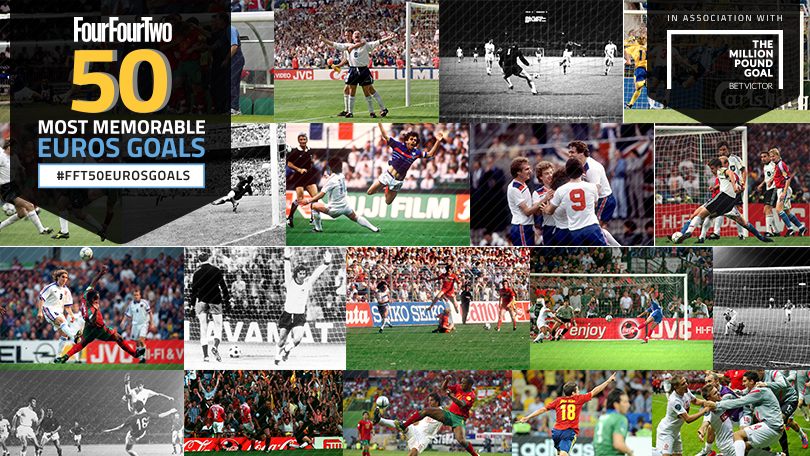The goal that defied the Nazis and killed a legend
Matthias Sindelar was arguably the finest player of the inter-war years, until a tap-in signalled the end of his career… and, depending on who you believe, his life. FFT tells his amazing story...
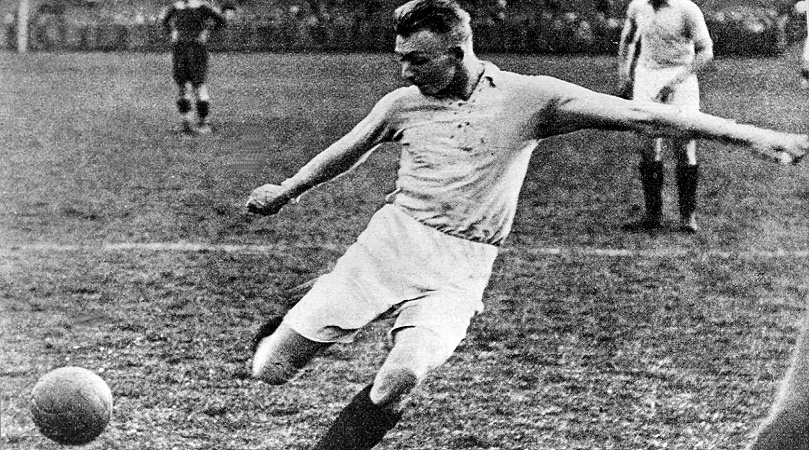
April 3, 1938, the Prater Stadium in Vienna. For 69 minutes Matthias Sindelar, playing for his national side, does as he’s told. He passes up chance after chance against Germany, who just a few weeks earlier annexed his beloved Austria. This game – designed as a celebration of this ‘connection’ – is an official welcoming back of Austria into the Reich. Having been advised not to score, Sindelar keeps missing the easiest of chances.
Then, in the 70th minute, he tucks home a rebound – much to the surprise of the 60,000 crowd, who are fully expecting the game to fizzle out into a diplomatic 0-0 draw. Then his team-mate and friend Schasti Sesta blasts home a free-kick to make it 2-0, and the pair dance a jig of delight in front of a box full of Nazi dignitaries.

Sindelar scores against Germany
Nine months later, after weeks of Gestapo harassment, Sindelar and his girlfriend are found dead in his Vienna apartment. Then it begins, as rumour becomes myth and myth becomes legend: Sindelar’s goal and subsequent ‘dance of death’, say the conspiracy theorists, led to him being murdered by the Nazis. But how much truth is there to the speculation – was Austria’s greatest player killed for celebrating a goal? FFT attempts to split fact and fiction.
Street footballer
Sindelar was spotted playing in the street with a ball made from rags and joined the local Hertha club at the age of 15, a year after his father was killed on the Italian front during World War I
Matthias Sindelar came from humble beginnings. His parents moved from Moravia to Vienna so his father, a mason, could find employment in the brickworks of the industrial district of Favoriten. It was in the grimy streets of this district that Sindelar learnt the skills that were to earn him the nickname ‘Der Papierene’ (The Paper Man) because of his ability to flit delicately through defences.
Sindelar was spotted playing in the street with a ball made from rags and joined the local Hertha club at the age of 15, a year after his father was killed on the Italian front during World War I. Before long he moved to the Vienna Amateurs, later to be renamed FK Austria Vienna, and soon broke into the first team despite a persistent knee injury. Many put his elusive style of play down to the fear of receiving a career-ending knock to his permanently bandaged knee.
Get FourFourTwo Newsletter
The best features, fun and footballing quizzes, straight to your inbox every week.
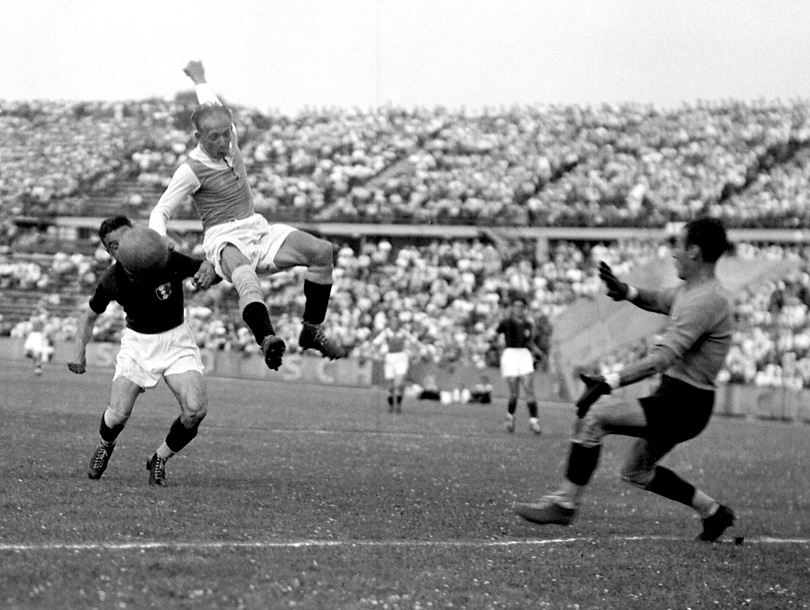
Sindelar captivated the fans of FK Austria, traditionally the club of the Jewish middle classes. His performances were described in the Viennese coffee-houses, where he would regularly drink and gamble with fans, in the same terms as those used to describe great acting or musical performances. In his first three seasons, Sindelar guided the team to three Austrian Cup victories and one league title. In 1933 they won the Mitropa Cup, beating Ambrosiana Milan (later to become Internazionale); three years later they repeated the feat against Slavia Prague.
Looks can be deceiving
He was a trim, almost frail-looking man, who looked as if he might blow away at any time; you wouldn’t have thought it possible that he could destroy a defence almost single-handed
Austria Vienna fan Fritz Polster’s father used to socialise with ‘Sindi’. “He was what I would call an old-fashioned superstar,” recalls Fritz. “There wasn’t the kind of hysteria which surrounds players these days; more a reverential hush.
“My father took me to meet him several times. He was a trim, almost frail-looking man, who looked as if he might blow away at any time; you wouldn’t have thought it possible that he could destroy a defence almost single-handed. But he did. Just being near him was a powerful experience.”
If Sindelar was a star at club level, it was on the international stage that he really flourished. In 1926 he made his debut for Austria, scoring the winner in a 2-1 victory over the Czechs then netting twice in a 7-1 demolition of Switzerland. A marvellous team was being assembled by manager Hugo Meisl and English coach Jimmy Hogan, and Sindelar was its focus.
World's greatest
The beautiful passing and lethal finishing displayed that day became a trademark, and for the next three years Austria dominated the world game
By the early ’30s, Austria had become arguably the best team in the world, earning the sobriquet of Wunderteam. The name was coined in May 1931, when a strong Scotland side were drubbed 5-0 in Vienna. The beautiful passing and lethal finishing displayed that day became a trademark, and for the next three years Austria dominated the world game.
In December 1932 they faced their sternest test: a match at Stamford Bridge against an England team never beaten at home by foreign opposition. Such was the importance of the match to the Austrians that 10,000 gathered in Vienna’s Heldenplatz to hear live commentary relayed through loudspeakers. The nervous visitors were two down after half an hour, but they soon realised England were not as good as they were cracked up to be and gradually came back into the game, with Sindelar scoring a fine solo goal. England somehow clung on to win 4-3.
The Times called Sindelar “one of the greatest players in the world”, the Daily Mail described him as “a genius”, and the famous Belgian referee John Langenus, who had officiated at the first World Cup final two years earlier, said Sindelar’s goal “was a masterpiece that no-one else could have scored against a team like England”.
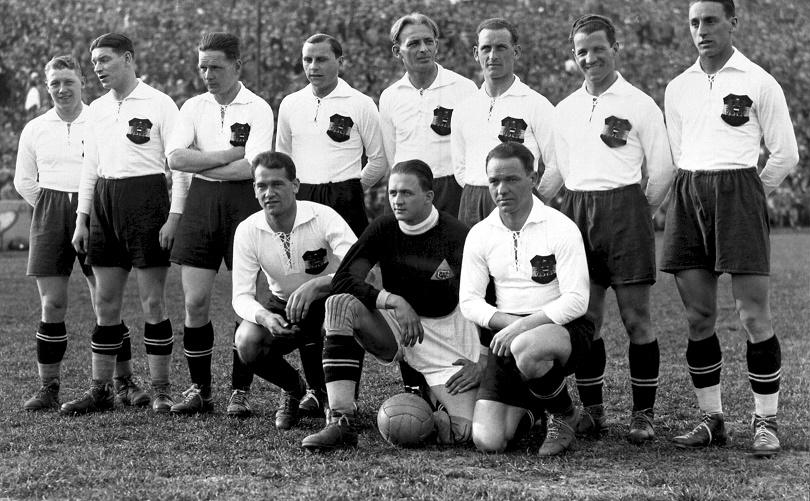
Already that year, Sindelar had scored a goal against Italy that became legendary: a corner came over from the right; he headed it over one defender, then another, then nodded the ball past the keeper into the corner.
National icon
He became a huge celebrity in Vienna, appearing in adverts for milk and watches and even in a feature film called Roxi and her Wonder Team
Sindelar was the undoubted star of a great team. He became a huge celebrity in Vienna, appearing in adverts for milk and watches and even in a feature film called Roxi and her Wonder Team. His reputation began to spread beyond the boundaries of Austria.
After Sindelar’s performance at Stamford Bridge, a host of clubs offered FK Austria huge sums for the striker, Manchester United included, but he was not interested in leaving his homeland. He was a man of simple tastes living in an apartment with his mother, who ran a laundry service. Riches and foreign adventure could not prise him from the team and country he loved.
In 1934, Austria were widely tipped to win the second World Cup in Italy, with Sindelar expected to be the star of the tournament. However, the economic troubles in Austria at the time meant the team could not afford to take a trainer or masseur with them. The Austrian season had finished late, so the players were also tired from a long, hard campaign.
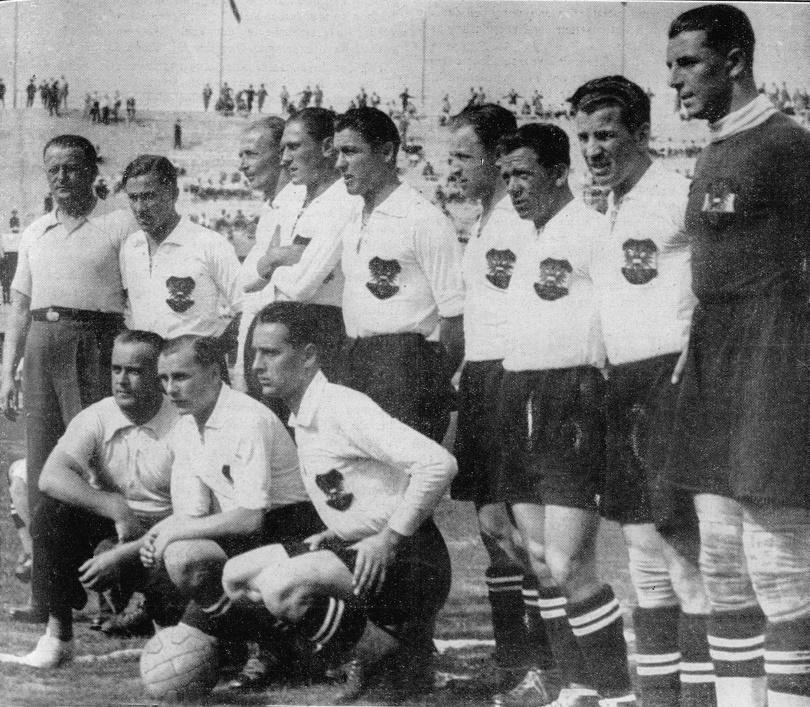
Controversial exit
The Italians won by a single, disputed, offside goal to nil, and Austria’s hopes of sealing their reputation with the Jules Rimet trophy were dashed
Despite these hardships, the Austrians reached the semi-finals, where they faced a home side keen to impress Mussolini. Heavy rain left the pitch a quagmire, which hampered the Austrians’ passing game, while Sindelar received some appalling treatment at the hands of Italian defender Luis Monti. He was one of the defenders humiliated by Sindelar’s heading trick two years earlier, and had told his manager Vittorio Pozzo: “When I see Sindelar, I see red.”
A hefty kick early on left the Austrian striker a passenger for the rest of the game, but that didn’t stop Monti administering more of the same, including one sly whack while Sindelar was lying injured on the ground. The Italians won by a single, disputed, offside goal to nil, and Austria’s hopes of sealing their reputation with the Jules Rimet trophy were dashed.
But that was just football. In 1938, Hitler’s tanks rolled across the border into Austria to complete the Anschluss, or ‘connection’. And this is where the Sindelar story becomes legend. A committed Social Democrat, Sindelar abhorred Nazism. As part of the chain of events that would eventually lead to the Holocaust, FK Austria’s Jewish players and officials were replaced and many forced into exile. The president of the club was removed in favour of a more ‘Aryan’ incumbent – who forbade contact with Jewish players and replaced a portrait of his predecessor in the boardroom with one of Hitler. The Nazis were not fond of FK Austria because of the club’s Jewish connections and also because their slick passing game put the less skilful, more direct German style to shame.

Hitler and Germany annexed Austria in March 1938
Political interference
Despite Austria having qualified for the 1938 World Cup, Anschluss meant the nation was now to be regarded as part of ‘Greater Germany’ and officially disappeared from the map
Football attempted to carry on with at least some semblance of normality, but the major difference was that Jews were no longer allowed in the game. FK Austria lost half a team and most of its officials. Those who remained were told not to mix with their Jewish former colleagues. Sindelar told axed president Michl Schwarz, “The new president has forbidden us to talk to you, but I will always talk to you, Herr Doktor!”
But it was with his feet that Sindelar most effectively registered his opposition. Despite Austria having qualified for the 1938 World Cup, Anschluss meant the nation was now to be regarded as part of ‘Greater Germany’ and officially disappeared from the map. The best Austrian players were to be absorbed into what was intended to be an all-conquering German side and a ‘reunification’ match was arranged for April 1938 in Vienna, with Sindelar captaining ‘old Austria’ against the new Austro-German side.
Sindelar and his team were warned that it would be inadvisable for them to score, let alone try to win. And yet that’s exactly what they did with those two goals from Sindelar and Sesta. A two-goal defeat and a jubilant jig: the Nazis weren’t impressed.
Even at 35 it was obvious Sindelar was still the greatest player in Austria. The authorities grudgingly invited him to ‘Reich training sessions’, but the requests were either ignored or Sindelar cried off citing injury. There was no way he was going to play for Nazi Germany.

A sorry end
On the morning of January 23, 1939, Matthias Sindelar was found dead in his apartment, above the coffee house he had acquired the previous year, lying next to Camilla Castagnola, his new girlfriend
After the war, Sepp Herberger – who managed the pre-war German team and later guided West Germany to victory in the 1954 World Cup – said Sindelar was “a fine man, whose memory will always be treasured in football circles”, adding: “I definitely had the impression that, when he cried off from our training camps, it was through discomfort with and a personal rejection of the political regime of the time.”
On the morning of January 23, 1939, Matthias Sindelar was found dead in his apartment, above the coffee house he had acquired the previous year, lying next to Camilla Castagnola, his new girlfriend. The official verdict was accidental death caused by carbon monoxide poisoning. However, the break-up of the team and city he loved had gradually forced Sindelar into depression and many felt he took his own life in a suicide pact with his girlfriend. There is a third theory, though: foul play. The police investigation was forcibly cancelled by the Nazis after a few months, and the files pertaining to the case disappeared soon afterwards.
“Some were convinced that Sindi had been murdered by the Nazis,” says Fritz Polster. “Others claimed he’d committed suicide. Having met the man and seen how vibrant and full of life he was, I’ve always doubted that.” The 1994 Cassell Soccer Companion said (wrongly) that he “was of Jewish descent, and committed suicide by gassing himself after the Nazis took over”. Suggestions that his girlfriend was half-Jewish were also incorrect.

Sindelar was found dead in his apartment in January 1939
“The stories are nonsense,” claims Polster. “Sindi had bought a cafe, and his girlfriend a bar. If they were Jewish, they’d have been banned from doing so. Any ‘undesirables’, as the Nazis described them, would never have got their hands on property.”
Nation in mourning
Sindelar’s funeral was attended by over 15,000 people, many of whom were convinced he had been killed by the Nazis
In 2003, the BBC screened a documentary entitled Football and Fascism, in which one of Sindelar’s friends, Egon Ulbrich, claimed a district official had been bribed to record Sindelar’s death as an accident to ensure he would receive a state funeral. “According to Nazi rules, a person who had been murdered or who had committed suicide could not be given a grave of honour, so we had to do something to ensure the criminal element in his death was removed,” explained Ulbrich.
A cover-up, in other words – but Polster has no time for conspiracy theories. “My father died shortly after that documentary was released and he still didn’t believe it,” he says, “mainly because everyone found out the malfunctioning chimney which pumped out carbon monoxide had made his neighbours ill the previous week.”
Sindelar’s funeral was attended by over 15,000 people, many of whom were convinced he had been killed by the Nazis. Renowned intellectual and journalist Alfred Polgar wrote in his obituary: “The good Sindelar followed the city, whose child and pride he was, to its death. He was so inextricably entwined with it that he had to die when it did.” There seems a bitter irony in the fact that this patriotic Austrian, having seen his country consumed by Nazi Germany, paid – in some people’s eyes – the ultimate price for scorning fascism.
Fritz Polster explains: “So much was written, so much was said, when Sindi died. His goal and his dance were hugely important to us. It was his way of saying, ‘I have my own sense of values and beliefs and you can’t take them away from me.’ In those terrible times in Europe, with fascism spreading, Sindelar’s celebration gave anyone who opposed the Nazis a reason to keep fighting.”

Killed In Action
Tragic proof that football doesn’t mix well with politics… or gambling… or guns
Javier De La Rosa, Panama
Chorillo FC striker De La Rosa was shot dead in May 2011 after a feisty Panamanian Cup semi-final with rivals Tauro FC. Rumours were that his assassins had wagered a large sum on Tauro to win the tie, and De La Rosa – who scored to help his side win – was in the wrong place at the wrong time in the car park after the game. “Our remaining strikers are scared to score now,” admitted the Chorillo chairman.
Haider Kadhim, Iraq
As Kadhim bore down on goal in a local league clash near Baghdad in March 2009, a masked gunman tore onto the pitch and assassinated him. Reports suggested that Kadhim had strong links to a Saddam Hussein-sympathising militia group, and that this murder was in effect a revenge killing by a member of the anti-Ba’athist forces. “Saddam was pushed out of power six years ago,” explained one of his team-mates, “but this just goes to show that the bad blood runs deep in Iraq.” Winning the Asian Cup in 2007 evidently didn’t have quite the unifying effect some Iraqis hoped.
Andres Escobar, Colombia
Two weeks after scoring an OG for Colombia at USA 94, Escobar was murdered outside a Medellin nightclub by a chauffeur who worked for local gangsters. Humberto Castro Munoz yelled “Gol!” as he fired, and police originally believed gambling drug lords had exacted revenge on Escobar for his error. Yet there is no evidence to support this, and the murder appears to have been a car-park bust-up gone tragically wrong.

Escobar's fateful own goal
This feature first appeared in the December 2012 issue of FourFourTwo magazine. Subscribe!
Goals: they're beautiful aren't they? This article is part of FourFourTwo's partnership with BetVictor and their Million Pound Goal campaign. Find out how to enter and more here.
Greg Lea is a freelance football journalist who's filled in wherever FourFourTwo needs him since 2014. He became a Crystal Palace fan after watching a 1-0 loss to Port Vale in 1998, and once got on the scoresheet in a primary school game against Wilfried Zaha's Whitehorse Manor (an own goal in an 8-0 defeat).
